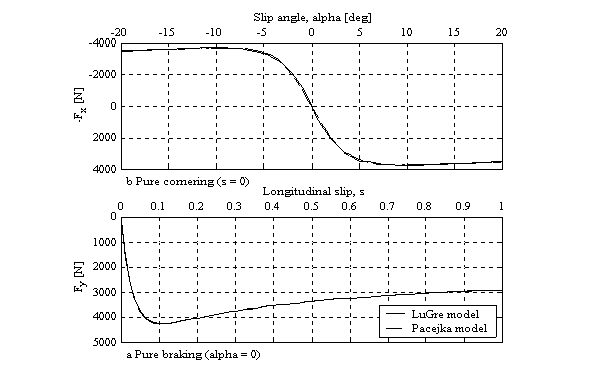Tire-road Friction Modeling
Vehicle motion is primarily determined by the friction forces transferred to the road by the tires. Therefore, a proper tire friction model is one of the key parts of the overall vehicle dynamics model intended for the use in different vehicle simulations, analysis, and control studies. Tire friction is traditionally modeled by utilizing static (kinematic) models, which can be given either in physical form (e.g. brush model) or empirical form (e.g. "magic formula"-based model).
However, there has been a significant research interest in modeling of tire friction dynamics in the recent years. This interest has been motivated by two observations: (i) the tire friction dynamics may be important from the standpoint of development of high performance ABS, traction control, and vehicle dynamics systems, and (ii) numerical difficulties of traditional static tire friction models at low vehicle speeds can be avoided by using a dynamic model.
Our research group has developed a dynamic tire friction model based on the brush representation of the tire-road contact. The model describes the longitudinal and lateral forces, as well as the self-aligning torque, for combined longitudinal and lateral motion. The elementary bristle-road friction contact is described by the friction model. The tire friction model has been originally derived in the spatially-distributed form for the uniform normal pressure distribution, and then converted to the lumped-parameter form with only three internal states. The distributed model has an analytical solution for the steady-state conditions, which can be used as the static model. In order to increase the accuracy of the self-aligning torque model, both static and dynamic tire friction models have been re-derived for the case of non-uniform normal pressure distribution.
The main characteristics of the proposed tire friction model are: integrated tire friction dynamics, high computing efficiency for the wide range of vehicle speeds, simple and compact mathematical formulation, and ease of model parameterization for different road conditions.
The model steady-state behavior has been validated with respect to "magic formula" model (Pacejka model). The below figure points out to the accuracy of the proposed model.
The model has been recently extended with several secondary, but potentially important effects such as camber, carcass compliance, conicity, ply-steer, and rolling resistance. All these effects relate to variable slip speed along the contact patch length. In order to preserve an analytical solution for static model and a simple, three-state lumped-parameter model form, the variable slip speed is approximated by a stepwise form. Qualitative and quantitative validation results have pointed to consistency of the proposed model extensions. One of the main benefits of the extensions is significant improvement of accuracy of self-aligning torque static curve due to the explicit description of carcass compliance effect.
The model has been recently extended with several secondary, but potentially important effects such as camber, carcass compliance, conicity, ply-steer, and rolling resistance. All these effects relate to variable slip speed along the contact patch length. In order to preserve an analytical solution for static model and a simple, three-state lumped-parameter model form, the variable slip speed is approximated by a stepwise form. Qualitative and quantitative validation results have pointed to consistency of the proposed model extensions. One of the main benefits of the extensions is significant improvement of accuracy of self-aligning torque static curve due to the explicit description of carcass compliance effect.
This research has been continued through the work on experimental identification and modeling of dynamic tire friction potential on ice surface.


Publications
-
Vehicle System Dynamics, Vol. 47, No. 7, pp. 831-850, 2009. -
A 3D Brush-type Dynamic Tire Friction Model
Vehicle System Dynamics, Vol. 42, No. 3, pp. 133-173, 2004. -
Modeling and Analysis of Tire Dynamics with respect to Wheel Torque Variations
Tire Technology International Annual Review, pp. 31-35, 2006. -
Extensions of LuGre Tire Friction Model Related to Variable Slip Speed Along Contact Patch Length
3rd International Tyre Colloquium "Tyre Models for Vehicle Dynamics Analysis", (TMVDA), IAVSD, Vienna, 2004.; Vehicle System Dynamics, Vol. 43, No. 1, pp. 508-524, 2005. -
On Low-slip Tire Friction Behavior and Modeling for Different Road Conditions
CD Proceedings of XIX IAVSD Symposium, Milan, Italy, 2005. -
A Brush-Type Dynamic Tire Friction Model for Non-Uniform Normal Pressure Distribution
CD-ROM Proceedings of 15th Triennial IFAC World Congress, Barcelona, Spain, 2002. -
Modeling and Analysis of Longitudinal Tire Dynamics Based on the LuGre Friction Model
Proceedings of 3rd IFAC Workshop Advances in Automotive Control, pp. 101-106, Karlsruhe, Germany, 2001. -
A Dynamic Tire Friction Model for Combined Longitudinal and Lateral Motion
2001 ASME International Mechanical Engineering Congress and Exposition (IMECE 2001), CD-ROM Proceedings, Vol. 2, New York, NY, 2001.